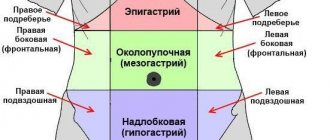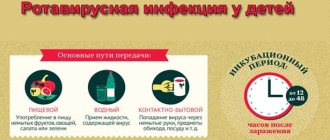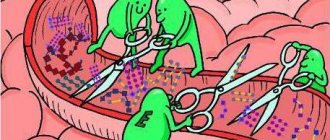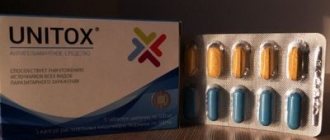Dyspepsia in children
The basis of the syndrome of functional dyspepsia in children is a violation of the neurohumoral regulation of the motor function of the upper gastrointestinal tract and visceral hypersensitivity. In this case, a disorder of the regulatory system can occur at any level: central (at the level of the central nervous system), peripheral (at the level of pathways), local (at the level of the receptor apparatus of the stomach and intestines, enteroendocrine cells, etc.) and entails dyskinesia of subordinates organs.
Simple dyspepsia in most cases is associated with nutritional factors - errors in feeding the child: overfeeding, monotonous nutrition, violation of the diet of the nursing mother, rapid transfer to artificial feeding, introduction of complementary foods. A feature of the digestion of young children is the adaptability of the gastrointestinal tract to food of a certain composition and quantity, so a sharp change in the nature of nutrition can lead to dyspepsia. One of the factors of dyspepsia in young children is overheating, leading to an increase in electrolyte losses through sweat and a decrease in the acidity of gastric juice.
In older children, simple dyspepsia can develop due to the abuse of fast food, soda, non-compliance with diet, increased study loads, and stressful situations.
Toxic dyspepsia or intestinal toxicosis in children can be the outcome of simple dyspepsia. An uncorrected diet and lack of treatment contribute to the absorption of toxic products of bacterial metabolism, general intoxication, and disruption of the liver, cardiovascular and nervous systems. In addition, toxic dyspepsia in children can develop against the background of acute intestinal infections: salmonellosis, dysentery, etc.
The development of parenteral dyspepsia in children is associated with the general impact of microbial or viral infection on the body. Digestive disorders are secondary in nature and are caused by the presence of other diseases in the child.
Almost all children are susceptible to dyspepsia, but more often this disorder affects premature babies, children with perinatal damage to the central nervous system, malnutrition, rickets, allergic reactions, hypovitaminosis, anemia, and exudative-catarrhal diathesis. Parasitic infestations (giardiasis) and helminthiases in children can occur with dyspeptic syndrome.
Manifestations and symptoms of dysbiosis in infants
- The child stops getting better. He loses the weight he gained.
- The skin changes. The skin becomes dry. Redness and peeling are noticeable. Even the corners of the lips are susceptible to chapped skin.
- There is a manifestation of allergic dermatitis, thrush or stomatitis on the mucous membrane.
- Decreased or completely absent appetite.
- The baby begins to suck at the breast poorly. Maybe after you start breastfeeding you can stop breastfeeding altogether.
- Constipation occurs in infants.
- The frequency of stools increases and the consistency of stool changes.
- Watery and green stool appears with pieces of mucus and bloody streaks and an unpleasant odor.
- The baby spits up or vomits.
- A putrid odor is felt with increased gas production.
- There is an increase in salivation.
- There are signs of flatulence, bloating and pain in the tummy.
- He begins to cry often, get nervous, and bend his legs.
- Suffers from various types of colds and intestinal infections.
Causes of dysbiosis in infants
A newly born baby has a sterile intestine. It does not contain any bacteria. All microorganisms are colonized through the maternal birth canal during labor.
The child cries often
The outside world greets the child with a huge number of bacteria. They are in the air, on the hands of doctors, on the clothes on the mother’s body.
At the beginning of a baby’s life, the microflora has different organisms. Gradually she becomes normal. Thanks to the action of mother's milk, which contains all the necessary components for growth. After about a week, bifidobacteria appear in the baby’s intestines, and by the month the baby is born, lactobacilli appear. They are observed from 90 to 95% in the intestinal microflora. This is a single ecological system. And if its balance is disturbed, dysbiosis appears.
The following situations can contribute to the development of the disease:
- Absence or insufficient quantity of some type of bacteria. (which, in turn, leads to intestinal upset, impaired immunity, metabolic disorders, the development of food allergies and rickets).
- If a nursing mother was forced to take antibiotics. Pathology was observed during childbirth.
- In case of late breastfeeding due to a long stay in the maternity hospital.
- Physiological immaturity of the intestines.
- Small pustular infections.
- Intestinal malabsorption.
- Weakened immunity.
- Early artificial feeding.
- Frequent acute viral diseases.
Parents do not need to conduct experiments on their child on their own to select a drug that is suitable for the baby. That's what doctors are for.
Do you want to be healthy and keep your body in good shape?
Join 1000+ people who receive interesting insider tips and advice on a healthy lifestyle, proper nutrition and training!
No spam, only useful and interesting content!
The main differences that any parent should remember:
- The metabolic rate of a child is always higher than that of an adult. It will slow down over time, but at the moment it is still high. This means that the student needs a more frequent diet and must be provided with three full meals and a couple of nutritious, but small snacks.
- Pay close attention to teenagers: due to hormonal changes in the body, they feel eternally hungry, and this is true! Provide your teen with a nutritious meal and several snack options using healthy foods. Make sure that the student eats the right food, not fast food and snacks.
- The child needs fewer calories to be full, but the number of meals should be greater. Ideally, 5-7 per day with breaks of no more than 4 hours. This is an excellent prevention of digestive diseases in children.
Features of a therapeutic diet in young children with acute digestive disorders
Acute digestive disorders are a common pathology in young children. Usually this is accompanied by diarrhea (diarrhea), which lasts no more than 5-8 days and may be accompanied by loss of fluid and electrolytes, and malnutrition. The occurrence of acute digestive disorders in a child at an early age is predisposed by the functioning of the gastrointestinal tract, such as a decrease in the mucus-forming function of the intestine, the content of secretory Ig A, a low supply of transport systems that regulate the reabsorption of sodium and chlorine, the child’s physiological mood for overhydration, low barrier intestinal function, reduced detoxification function of the liver.
The cause of acute gastrointestinal disorders in most cases is a bacterial or viral infection. The bacteria can cause diarrhea due to the secretion of an exotoxin when they enter the intestinal mucosa. Depending on whether or not the pathogen has penetrated the mucous membrane, the infection can be invasive (Shigella and Salmonella) or non-invasive (some strains of Colibacillus and Vibrio cholera). The cause of the disease can also be opportunistic microorganisms (staphylococcus), which in low concentrations are part of the normal microflora of the colon of a healthy child. In 70% of cases, the causative agents of diarrhea are rotaviruses. The cause of acute digestive disorders may be an incorrect diet (overfeeding, unbalanced diet) or food intolerance. In the latter case, the disease becomes chronic. Usually, with acute viral gastroenteritis, complete restoration of the intestinal epithelium occurs 7-10 days after the end of virus excretion, although in children under one year of age this process can take up to 6-12 weeks.
Currently, disturbances in the absorption and secretory functions of the digestive tract that occur during acute diarrhea have been quite well studied. It is known that four main mechanisms are important in the pathogenesis of diarrhea: intestinal hypersecretion, increased osmotic pressure in the intestinal cavity, impaired transit of intestinal contents and intestinal hyperexudation, which leads to loss of water and salts. This is often accompanied by impaired fat absorption, inhibition of lactase synthesis and the development of secondary lactase deficiency.
The severity of clinical manifestations in acute digestive disorders depends on the etiology of the disease. In the absence of timely treatment, dehydration develops, which determines the severity of the disease. Therefore, in the treatment of acute diarrhea in young children, the main attention should be paid to combating dehydration and nutritional therapy. The main objectives of diet therapy for acute diarrhea are to replenish fluid loss, replace loss of electrolytes, reduce the intake of lactose and fats in the body, ensure the body's energy needs, prevent metabolic disorders associated with malnutrition and protein catabolism in the child's body. Previously practiced long-term restrictions in the diet of a sick child, fasting diets during illness are now considered inappropriate. Observations show that children endure long-term food restrictions much more difficult than adults, since the growing child’s body experiences a higher need for basic nutrients than the mature body of an adult [1]. In a child, all metabolic processes occur with great tension, which requires significant energy consumption. In addition, it is noted that during illness these processes are often activated. Therefore, in case of acute intestinal infections, long-term quantitative and qualitative restrictions in the nutrition of a young child are inappropriate. This approach is possible only at the very beginning of the disease, after which in a fairly short time (usually within 1-4 days) it is necessary to switch to a nutritious diet appropriate to the age and physical development of the child.
Considering the fact that the absorption of breast milk in acute diarrhea is rarely impaired (only in 4% of patients), breastfed children should continue to be breastfed, while maintaining the physiological rhythm of feeding 6-7 times a day (depending on age ). On the first day, depending on the baby’s appetite, the amount of food can be reduced by no more than 50-75% of the age-appropriate amount of food, and then within 2-3 days it should be increased to the age norm. Alternating between taking rehydration solutions and breastfeeding usually reduces stool frequency and improves stool consistency.
For children who are bottle-fed, a fasting diet is prescribed for 6-8 hours. At this time, highly specialized rice-based products can be used: water and salt balance restorer, BIO-rice broth, carrot-rice broth ORS-200 (HiPP, Austria). Subsequently, the child is given milk formula in half the volume of the usual portion, followed by restoration to normal. A special therapeutic mixture for acute intestinal disorders is Humana LP (Germany), which contains dietary fiber from bananas, which have a high ability to bind excess water in the intestines and help reduce fluid loss during diarrhea. When passing through the intestines, dietary fiber forms a fibrous or amorphous matrix of a “molecular sieve” type, the physicochemical properties of which determine the ability to retain water, cation exchange and adsorption properties, and sensitivity to bacterial fermentation in the colon. The presence of hydroxyl and carboxyl groups in dietary fibers contributes, in addition to hydration, to ion-exchange swelling. Degradation of dietary fiber occurs under the influence of intestinal microflora. Pectin and most of the hemicelluloses that make up banana dietary fiber are completely destroyed, lignin and, to a lesser extent, cellulose are resistant to bacterial attack and pass into feces. The predominant anaerobic bacteria in the colon are saccharolytics and are capable of digesting many types of non-starch polysaccharides. During fermentation, the most important products are released - short-chain fatty acids: monocarboxylic (acetic, propionic, butyric, etc.), dicarboxylic (succinic), hydroxy acids (lactic), amino acids. Short fatty acids and other metabolites of dietary banana fibers have a number of positive local and systemic effects on the macroorganism: supply of substrates for lipo- and neoglucogenesis, maintenance of ion exchange, antibacterial effect, activation of local immunity and blocking the adhesion of pathogens, maintenance and differentiation of the epithelium, and much more. etc. It is important to note that this mixture does not contain lactose, which is of particular importance in the development of secondary lactase deficiency. Since fat absorption is impaired in acute intestinal infections, the fat content in the Humana LP mixture is low and is represented mainly by easily digestible polyunsaturated fatty acids and triglycerides with medium-chain fatty acid residues. Gluten is not included in the mixture, since its early administration to children with intestinal infection contributes to the clinical manifestation of celiac disease in the presence of a predisposition to this disease. The high protein content in the Humana LP mixture reduces the degree of intestinal disorders and ensures the normal course of recovery processes in the body during the recovery period after an infectious disease.
For acute diarrhea, children can also be given fermented milk mixtures [2]. The ability of these products to stimulate the immune response in infants, as well as the bactericidal effect of lactic acid, underlie the therapeutic effect of fermented milk mixtures for intestinal infections [3]. As for the stimulating effect of these products on the immune response, its mechanism apparently includes activation of the production of immune response regulators, in particular interleukins and interferon g, in combination with an increase in the local response of enterocytes [4]. Along with anti-infective and probiotic effects, fermented milk products have a beneficial effect on intestinal motility. Undoubtedly, the advantages of fermented milk products are also the high digestibility of milk protein and the reduced level of lactose associated with the partial breakdown of these substances under the influence of lactic acid microorganisms during the fermentation process. For acute intestinal infections in young children, fermented milk products such as Acidolact, Agu-1, Agu-2, Adalakt, BIFI kefir, Bifilin, Biolact with lysozyme, Bifilin-M, Biokefir, Narine can be used.
As digestion is restored and the activity of the gastrointestinal tract normalizes, they gradually return to the child’s normal feeding regimen. For children under 3-4 months of age with diarrhea of infectious origin, in order to prevent food allergies to cow's milk proteins, hypoallergenic mixtures with a low degree of hydrolysis are recommended: Humana GA-1 (Humana, Germany), HiPP-GA-1 (HiPP, Austria ), Friesopep-1 (Friesland Newtrition, the Netherlands). This cautious approach is determined by the risk of allergy to cow's milk proteins associated with damage to the intestinal mucosa. Given this danger, products containing protein hydrolysates are prescribed for up to 2-3 weeks, even if the disease is mild [5, 6]. If the course of diarrhea was severe, formulas based on partially hydrolyzed proteins continue to be given to the child until 4-5 months of age, after which they switch to feeding formulas of the second age group: Samper Baby 2, Humana 2, Humana Baby Fit, Frisomel, Enfamil 2. If a child has an allergy to cow's milk and soy proteins, dietary foods containing highly hydrolyzed proteins are introduced into the diet: Alfare (Nestlé), Pepti Junior (Nutrizia), Tutteli Peptidi (Valio).
Lactose-free formulas are recommended for children aged 3 to 6 months, even if the diarrhea is mild [6]. In these cases, you can use mixtures of Frisosoy (Friesland Nutrition, the Netherlands), Humana LP (Humana), AL 110 (Nestlé), Nutrilon low-lactose (Nutritsia), Soya-Sam (Samper). Children over 7 months are prescribed low-lactose milk Nutritek (Russia). For mild lactase deficiency, it is possible to use fermented milk mixtures [7]. For children with secondary lactase deficiency, low-lactose nutrition is indicated for 3-4 months. The criteria for the effectiveness of the therapy are the elimination of clinical manifestations, including normalization of stool character and stable weight gain. After this, a gradual expansion of the diet is possible. In children over 6 months of age, precautions regarding the use of medicinal mixtures remain relevant, but to a lesser extent.
After complete rehydration and restoration of appetite, the child should be given well-cooked, pureed, easily digestible food: rice, cereals, very ripe bananas (fresh or boiled, whole or chopped in a mixer), potatoes, apples (fresh grated or baked), fruit puree in jars (apple, banana, pear). It is necessary to return to a balanced diet as soon as possible.
Literature
- Ardatskaya M. D. Metabolic effects of dietary fiber, Russian Journal of GGC, No. 4. volume 11, pp. 91-102.
- Feeding children in the first year of life. A manual for doctors and students of pediatric faculties of medical universities; Ed. Samsygina G. A. M., 2001. P. 67.
- Kon I. Ya. Specialized medical nutrition products: characteristics and use in young children // Children's Doctor. 2000. No. 3. P. 43-47.
- Kuvaeva I. B., Ladodo K. S. Microecological and immune disorders in children. M.: Medicine, 1991. P. 270.
- Specialized food products for children with various pathologies. Catalog; Ed. Ladodo K. S., Sazhikova G. Yu. (ed.). M., 2000. 200 p.
- Shenderov B. A. Medical microbial ecology and functional nutrition. M., 1998. P. 285.
- Brown KH et al. Use of the non-human milk in the dietary management of young children with acute diarrhea: a metaanalysis of clinical trials//Pediatrics. 1994. Vol. 94. P. 17-26.
- Snyder JD, Molla AM, Cash RA Home-based therapy for diarrhea//J. Pediatr. Gastroenterol. Nutr. 1990. No. 11. P. 438-447.
Diagnosis of dysbacteriosis
The correct diagnosis will be made after laboratory diagnostics. To make a correct diagnosis, several testing methods are used:
- Coptogram
- Stool analysis for opportunistic flora
- Stool analysis for dysbacteriosis
To identify how food components are digested by the baby’s intestines, a coptogram is made. To determine the level of neutral bacteria, the second method is used. And to determine the amount of normal and opportunistic zones and sensitivity to drugs, a third analysis is done.
The child's feces for analysis should only be collected. It should not be stored outdoors for a long time. The amount for analysis is from 5 to 10 grams. When testing feces for dysbiosis, it is advisable not to give the child normal flora preparations at this time. The attending physician will give advice on this matter. After stool tests, a diagnosis is made and treatment begins.
Diet for digestive disorders in schoolchildren
For acute eating and digestive disorders in children, it is better to consult a doctor. But building the right diet and instilling healthy eating habits in a child is only possible in the family.
Here are some basic principles for building a diet.
- Be sure to prepare breakfast for your child. This should be a hot dish with a sufficient content of slow carbohydrates: porridge, pasta with butter or cheese. Breakfast must include a protein dish. It could be an omelet, cottage cheese, a piece of lean boiled meat. An addition to this breakfast will be tea with milk, a fermented milk drink. 1-2 times a week you can give cocoa or a nutritious drink based on carob.
- Do not force your child to eat quickly and finish everything. When we eat slowly, we become full with less food. Stuffing food into yourself when you can’t handle it anymore is the first step towards an eating disorder and subsequent weight gain.
- Pack snack bags for school. Despite the fact that schools most often provide hot meals, snacks are never superfluous. In the bag, put something that will not spoil at room temperature - fresh fruit, some cookies, preferably homemade.
- Make sure the student has a full lunch. For the healthy functioning of the gastrointestinal tract, the child must receive hot food, including the first course - soup every day. Ideally, it will be made with vegetable, chicken or low-fat meat broth. But it is better to avoid soups with strong broths, fatty and spicy ones.
- Watch your drinking regime. It is necessary that the child always has drinking water at hand. Avoid carbonated drinks, sweet juices and nectars.
- To improve digestion, the child needs to ensure that the diet contains a sufficient amount of vegetables and fruits, which contain a large amount of fiber. This normalizes the intestinal flora and allows you to improve digestion without taking special medications.
- You can enrich a student’s diet with protein, which is so necessary for growth and development, by adding balanced protein mixtures to their usual daily meals. Protein mixtures do not change the taste of food, but they increase the amount of easily digestible protein.
A balanced diet is very important for the proper development of your child.
The best way to ensure that a student gets all the nutrients they need to grow is to personally control what they eat and instill healthy eating habits from childhood.
Types of dysbiosis in infants
Dysbacteriosis has 2 types:
- Compensated
- Uncompensated
Bloating makes your baby feel uncomfortable
The baby's microflora is formed from birth. In the compensated form, the presence of dysbacteriosis can be detected only by donating stool. Externally, clinically, it does not manifest itself. The child feels well.
With dysbiosis in infants, there is a decrease in the number of beneficial bacteria.
And “neutral”, “bad” bacteria, on the contrary, begin to populate the body. Although, sometimes, and this is observed quite often, dysbiosis is a temporary ailment. Because the action of beneficial microorganisms restores balance. But there are cases when certain medications are also required.
Uncompensated dysbacteriosis has all the clinical signs. They were mentioned above. In this case, it is necessary to urgently treat the baby. The most effective treatment is breastfeeding. If it is not possible to breastfeed, then it is necessary to use adapted formulas that are endowed with protective factors. When taking such drugs, medical advice is required.










